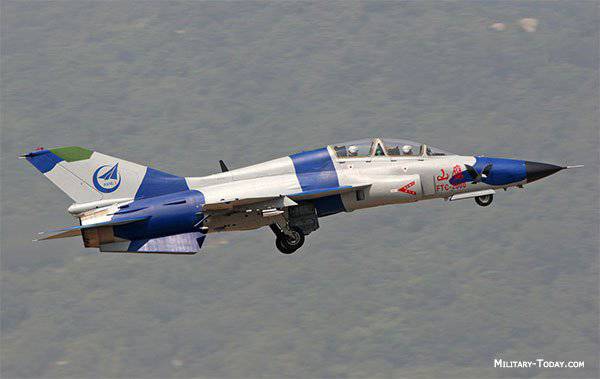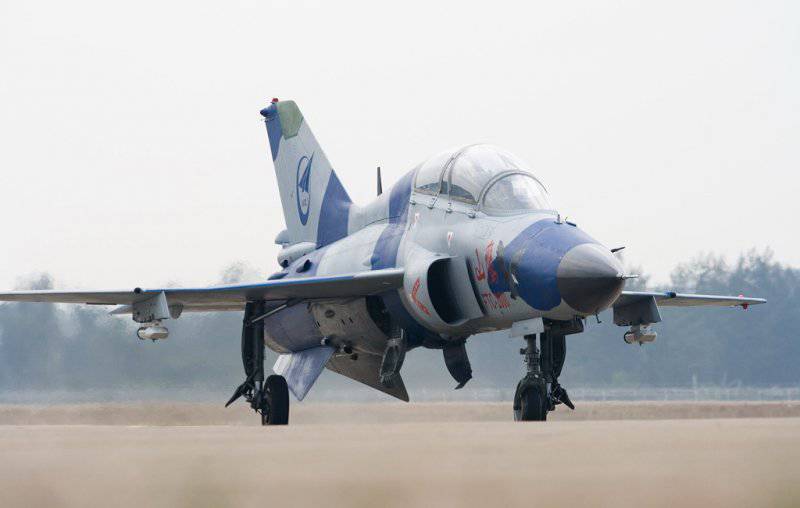Chinese training fighter "Mountain Eagle"
In 2011, PLA’s Guizhou JL-9 / JJ-7B TCB was accepted as the Mountain Eagle in the PLA air force. To appreciate the fullness of this acquisition, consider the process of learning Chinese pilots.
The preparation process is very similar to the system used in the Soviet Union, and it is called something like this - five steps and three phases.
The 1 phase includes two steps:
- initial training, the basis of which is theoretical training and initial training at the piston Nanjet CJ-6 TCB
- the main in this phase - training on a jet trainer training aircraft Nanchang L-11 / K-8
All flight skills training takes place in military schools.
The 2 phase also consists of the 2 phase:
- pilots arrive for further training in the Air Force, where they practice flights on the TCF Guizhou JJ-7;
- then the pilots start training on the Chengdu J-7 and Shenyang J-8 aircraft.
These are already real fighters on which the Chinese pilots are trained.
The last, the 3 phase, consists of the 5 stage:
- Pilots move to another air base to gain tactical training skills on J-8 / J-7 fighters.
But there is a big fly in the ointment - in the PRC, for the banal reason of lack of funds and a rather rigid ideology, all pilots are trained on the same type aviation technology, as a result of which this technique is not completely effective.
A good example of this technique is the Guizhou JJ-7, which is a modernized outdated Soviet MiG_21US. The aircraft itself is used to increase the flight training of those pilots who control the J-7 and J-8 fighters, and on the Guizhou JJ-7 you cannot use the entire flight program of these aircraft, which are also quite complicated to manage.
As a result of these problems, untrained pilots are put in fighters with a single cabin, which leads to longer training, as there is no such thing as an instructor who could prompt and pay attention to the mistakes made.
Therefore, in order to become a second-generation pilot (in our opinion, the third generation), he will have to fly at least 4s of various training and combat aircraft, and in order to reach the internal 3 generation, you will need to fly around 6 types of different aircraft. Very complex, costly and inefficient system.

Another drawback of old aircraft is the impossibility of training highly skilled pilots for modern aircraft. J-7G / H and J-8H / F are already using target designation systems, equipped with viewing and control monitors, navigation inertial system. And the pilots who have been trained on the JJ-7 have practically no experience in managing these systems and cannot fully fly the latest aircraft.
This system is absolutely ineffective for training pilots to control the 3 generation aircraft - Shengyang J-11 and Chengdu J-10, which began to appear rather quickly in the PRC Armed Forces. Because of this, it was necessary to buy UBS Su-27BK, as time has shown, this acquisition did not completely solve the problems. UBS Su-27BK began to be used in the same way as other training aircraft - for training all pilots to control 3-generation airplanes, which led to the complete exhaustion of the aircraft data resource. In addition, a huge technical gap between the Su-27BK and JJ-7 led to a high number of flight accidents.
Therefore, the two manufacturers of aircraft manufacturers Guizhou Aircraft Manufactory and Nanchang Aircraft Manufactory are beginning to develop a low-cost modern model of training for pilots to manage 3-generation aircraft.
History creation.
Guizhou is actually a very small company that produced only JJ-7. In 2001, the company offers a training aircraft based on the JJ-7 called FTC-2000, a little later the name will be replaced by JL-9. Although the plane was not much different from the parent JJ-7, the main difference was the side air intakes and the wing with a double delta. If the project did not go into the series, the company would most likely go bankrupt. But be that as it may, by the end of 2002, the design part of the new training aircraft was completely ready.
On the plane, according to the project, installed WP-13 TRD, which has been produced for more than twenty years. The build of the prototype because of this solution went very quickly, by the end of October 2003, the prototype was ready. The prototype made its first flight in the middle of December 2003, and in 2006, it was officially presented at the Zhuhai air show.
According to the developers, this TCB should reduce the gap between the initial and professional training. Modified side air intakes allowed the designers to install radars and OMS at the front of the aircraft. Such an approach will allow smoothing the transition from a training to a military plane of cadets of military schools.
In the 2007 year, several JL-9 samples are sent to the air force to conduct a test cycle. There also change the name of the TCB to JJ-7B. In the 2011 year, the JJ-7B airborne control system put the Air Force into operation, the naval forces use this aircraft to acquire land aviation skills by the pilots.
JT-9 modification for the Navy.
China’s ambitions to strengthen naval aircraft carriers are well known. This means that the Chinese Navy badly needs TCB deck appointments. For these purposes, the Chinese Navy has already acquired the Su-25UTG. But most likely the Chinese Navy will use the deck version of the JL-9, which just recently made its first sea voyage. Externally, it differs from the base aircraft with an increased area and contours and the presence of a hook for landing on the deck. The chassis remained unchanged, which will enable operation from ground airfields. In the middle of 2011, the Chinese military announced that this modification is called JT-9.
Tests of deck modification continue, but based on the fact that this aircraft is almost twice as cheap as the nearest competitor, it will be adopted by the Chinese Navy.

Information